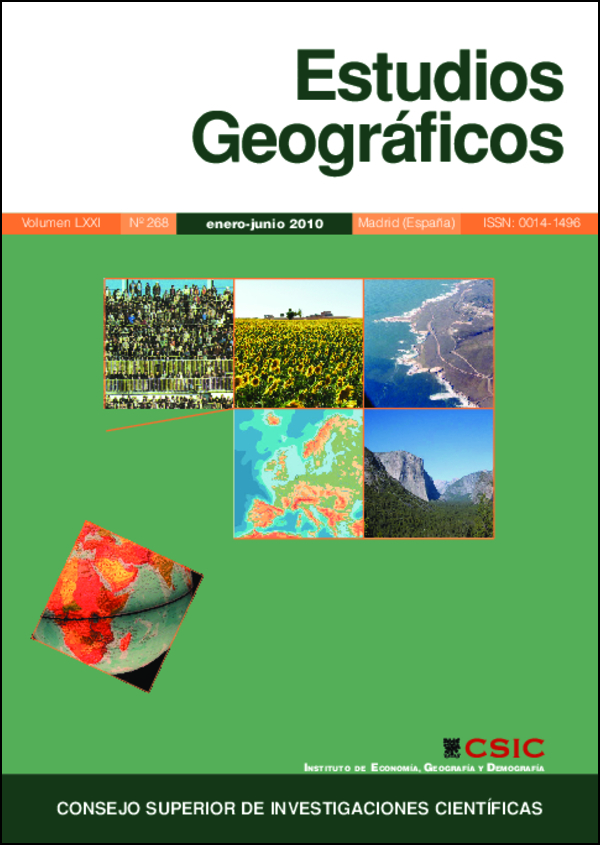Mapping Of Salt-Affected soils using Landsat images in tierra de Medina (Valladolid, Spain)
DOI:
https://doi.org/10.3989/estgeogr.0452Keywords:
remote sensing, saline soils, Valladolid (Spain)Abstract
The main goal of this study is the mapping of saline soils (solonchaks, solonetzs and luvisols with salic phases) in «Tierra de Medina» (Valladolid) using images of the TM and ETM sensors of the Landsat satellites. The spectral signatures of these soils show very high digital values, which allows to differentiate them from other types of soils and superficial covers. The highest values correspond to those which have salt efflorescences and the lowest values to soils affected by hydromorphic processes. The images obtained with the NDVI do not allow a clear discrimination of saline soils, but they allow to interpret the changes in their use. In these soils the values of NDVI are very low, due to their scarce vegetation. There is a remarkable vegetation reduction between years 1987 and 2001, which implies a structure deterioration and a great loss of vegetal cover; many of soils affected by salinization have not been cultivated any more.
Downloads
References
Dwivedi, R. S. (1996): “Monitoring of Salt-affected soils of Indo-Gangetic alluvial plains using principal component análisis”. Int. J. Rem. Sens., 17: 1907-1914. doi:10.1080/01431169608948746
Dwivedi, R., Sreenivas, K. and Ramana, K. V. (1999): “Inventory of salt-affected soils and waterlogged area: a remote sensing approach”. Int. J. Rem. Sens., 20: 1589-1599. doi:10.1080/014311699212623
F.A.O. (1989): Mapa mundial de suelos. FAO. Roma.
Forteza, J. et al. (1987): Memoria del mapa de suelos de Castilla y León. Escala 1:500.000. Edit. Junta de Castilla y León. Valladolid, 98 pp.
Garcia, A. et al. (1985): Estudio edáfico de la provincia de Valladolid. Mapa de suelos escala 1:100.000 de la zona situada al sur del río Duero. C.S.I.C., 206 pp.
Garcia, M. P. (1986): “Contribución de la mineralogía de la fracción arena al estudio de la edafogénesis en una zona semiárida de la provincia de Valladolid. I - Análisis mineralógico. Interpretación general”. Anales de Edafología y Agrobiología, XLV, 1539-1566.
Garcia, M. P., Forteza, J., Garcia, A. y Lorenzo L. F. (1986): “Soils affected by hidromorphism in certain zones of Castilla-León (Spain) characterized by a xeric moisture regime”. XIII Congreso Sociedad Internacional de la Ciencia del Suelo Hamburg (R.F.A.).
García M. P. (2001): Problemática y distribución de los suelos salinos en Castilla-León. Espacio Natural y dinámicas Territoriales (Manero coord). Univ. de Valladolid, X, 143-148 pp.
Hick, P. T. and Russell, W. G. R. (1990): “Some spectral considerations for remote sensing of soil salinity”. Australian Journal of Soil Research, 28: 417-431. doi:10.1071/SR9900417
Kalra, N. K. and Kalra, D. C. (1996): “Potentiality of Landsat, Spot and IRS satellite imageries for recognition of salt affected soils in Indian arid zone”. Int. J. Rem. Sens., 17: 3001-3014. doi:10.1080/01431169608949124
Kienast-Brown, S. and Boettinger, J. L. (2007): “Land-cover classification from Landsat imagery for mapping dynamic wet and saline soils”. Development in Soil Science, vol. 31. Lagacherie, P., McBratney, A. B. and Voltz, M. (edit.). Elsevier, 235-244.
Metternicht, G. y Zinck J. A. (1997): “Spatial discrimination of salt and sodium affected soil surfaces”. Int. Journ. of Remote Sensing, vol. 18, 2571-2586. doi:10.1080/014311697217486
Metternicht, G. y Zinck, J. A. (2003): “Remote sensing of soil salinity: potentials and constraints”. Remote Sensing of Environment, vol. 85, 1-20. doi:10.1016/S0034-4257(02)00188-8
Mougenot, B. (1993): “Effects des sels sur la réflectance et télédétection des sols sales”. Cahiers ORSTOM, Serie Pedologie 28, 45-54.
Peng, W. (1998): “Synthetic análisis for extracting information on soil salinity using remote sensing and GIS: a case study of Yanggao basin in China”. Environmental Management, 22: 153-159. doi:10.1007/s002679900092 PMid:9419293
Pérez González, Mª E. y García Rodríguez, Mª P. (2005): “Discriminación visual y digital de suelos de baja calidad agrícola a partir de imágenes Landsat”. Geographicalia, 46: 99-115.
Perez González, M. E., García Rodríguez, Mª P., González-Quiñones, V. and Jiménez Ballesta, R. (2006): “Spatial variability of soil quality in the surroundings of a saline lake environment”. Environmental Geology, vol. 51, nº 1, 143-150. doi:10.1007/s00254-006-0317-y
Rao, B. and Venkataratnam, L. (1991): “Monitoring of salts affected soils; a study using aerial photographs, Salyut-7 space photographs and Landsat TM data”. Geocarto Int. 6, 5-11. doi:10.1080/10106049109354288
Schmid, T. F. (2004): Integrated Remote Sensing approach to detect changes in semi-arid wetland areas in Central Spain. Tesis Doctoral. Univ. Autónoma de Madrid, 193 pp.
WRBSR (2007): World reference base for soil resources. FAO. ISRIC.
Downloads
Published
How to Cite
Issue
Section
License
Copyright (c) 2010 Consejo Superior de Investigaciones Científicas (CSIC)

This work is licensed under a Creative Commons Attribution 4.0 International License.
© CSIC. Manuscripts published in both the print and online versions of this journal are the property of the Consejo Superior de Investigaciones Científicas, and quoting this source is a requirement for any partial or full reproduction.
All contents of this electronic edition, except where otherwise noted, are distributed under a Creative Commons Attribution 4.0 International (CC BY 4.0) licence. You may read the basic information and the legal text of the licence. The indication of the CC BY 4.0 licence must be expressly stated in this way when necessary.
Self-archiving in repositories, personal webpages or similar, of any version other than the final version of the work produced by the publisher, is not allowed.















